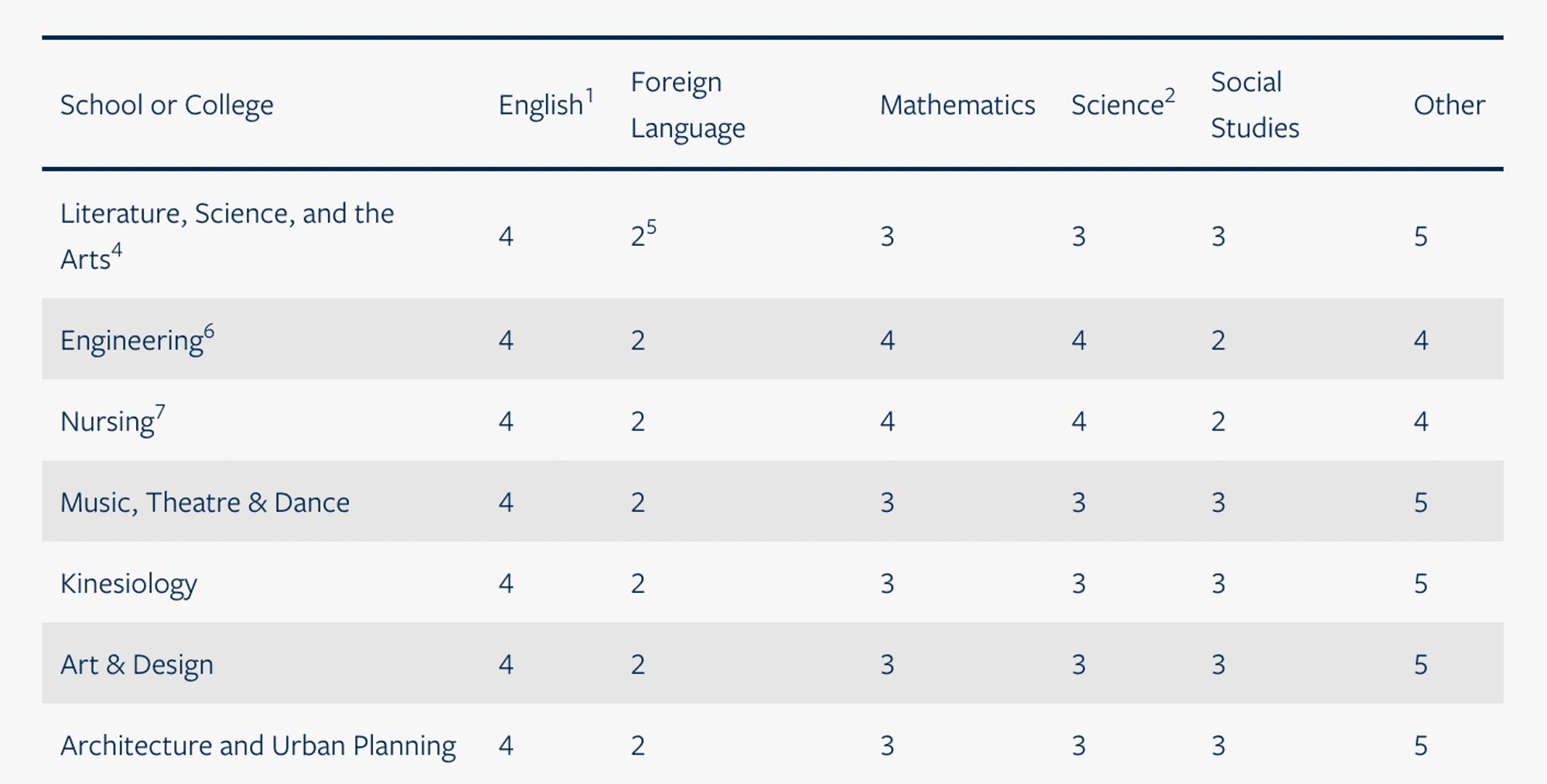Contents
Last updated March 21, 2024
Every piece we write is researched and vetted by a former admissions officer. Read about our mission to pull back the admissions curtain.
How to Get into University of Michigan
Admissions officer reviewed by
Ben Bousquet, M.Ed
Former Vanderbilt University
Written by
Kylie Kistner, MA
Former Willamette University Admissions
Key Takeaway
So you want to go to the University of Michigan, eh? You betcha!
Casseroles aside, the University of Michigan is one of the best schools in the country. In particular, it’s widely recognized for its engineering programs.
The University of Michigan is one of the handful of large state universities that carry the same kind of prestige you can get at highly-selective private institutions, so it’s a great one to put on your list.
It also has an acceptance rate to match—only 20%. Compared to MIT’s 4.1%, that 20% may seem like an easy, breezy day on Lake Erie. But it’s anything but. At that level, you’ll still need to craft a smart application strategy.
In this post, we show you how to do just that.
Let’s get started.
How to Apply to University of Michigan
To apply to UMich, you’ll need a Common Application account. Once you add the University of Michigan to your school list, you’ll also need to select one of UMich’s schools or colleges to apply to. The school you apply to should house the major you want to study.
Once that’s out of the way, you’ll need all the basics: your background information, personal statement, activities list, transcript, school report, standardized test scores, and recommendations. You’ll also need to fill out the University of Michigan supplement.
University of Michigan Application Options
You have two application plans to choose from: Early Action and Regular Decision.
Yep, that’s right—no Early Decision option. Even if University of Michigan is your number one, very top choice, you’ll still have to apply EA or RD.
University of Michigan Application Deadlines
Early Action: November 1
Regular Decision: February 1
As far as Regular Decision due dates go, UMich has a very generous one. If it’s late in the season but you’re still looking for great options, look no further.
How hard is it to get into University of Michigan?
Statistically, it’s a lot easier to get into the University of Michigan than it is to get into, say, Harvard. But that doesn’t mean that becoming a wolverine is easy.
At 20%, we’d consider the University of Michigan a competitive school. For many of you, it will probably fall into the “reach” category on your school list.
What does University of Michigan look for in applicants?
“We look at each student as a whole package,” the UMich admissions website declares.
Despite its large size and high application volume, the University of Michigan still takes a holistic approach to evaluating applicants. Admissions officers aren’t only looking at your grades or test scores. They’re also assessing your extracurricular achievement, writing skills, leadership, and recommendation comments.
The UMich admissions office is also generous enough to give a clear breakdown of how admissions officers score applicants. Let’s take a look.
The website explains that admissions officers score applicants on five criteria: high school academic performance, something they refer to as “educational environment,” counselor and teacher recommendations, essays, and extra factors like awards and involvement.
University of Michigan admissions officers want to see that you’ve taken the most challenging course load you can, you’ve done well in your classes, and you have been an active part of your community. Simple, right? (We know, it’s not.)
Once these categories have been scored, application reviewers give the applicant an overall rating on a five-point scale that ranges from “below average/poor” to “outstanding.”
These scores are combined with the entire holistic review process to give you, the applicant, your ultimate admissions decision.
University of Michigan GPA requirement
We’ve already broken down all of the University of Michigan GPA data in our UMich Common Data Set post, but there are a few things worth re-covering here.
As the UM Common Data Set reports, 33.4% of enrolled first-year students had a perfect 4.0 GPA. The majority of students were in the 3.75 to 3.99 range. Only 11.8% had below a 3.5 GPA.
Using this data, you can assess how your own GPA stacks up against the kinds of students who are applying to UMich.
If you’re below the 3.5 unweighted range, then your other application components will have to work even harder.
But if you’re above that range, then your application will have a better shot at ranking well in the UMich scoring system. But don’t think that you’re a shoo-in if our other application components should still follow suit.
University of Michigan SAT Scores
You’ve heard of test required and test optional. Now get ready for…test-flexible!
Test-flexible adds another layer to the already convoluted world of standardized testing. It’s similar to test-optional, but it’s a little bit less optional.
At a test-optional school, you can relatively safely bet that omitting your test scores won’t have a huge impact on your application (although there’s some debate about whether that’s true—see our strategy post on test-optional admissions for more details).
Test-flexible schools, on the other hand, don’t require you to submit a score, but they do prefer it. Since UMich is a test-flexible school, you should think about submitting them, especially if they’re at or above the middle 50%.
The middle 50% ranges at UMich are:
SAT Composite: 1360-1530
ACT Composite: 31-35
You’ll notice that these ranges have lower bottom scores than other competitive schools, so you may have a bit more flexibility if your score is good but not perfect.
Does University of Michigan superscore?
Yup. The University of Michigan superscores. They’ll take your best scores from each section of the SAT or ACT, and they’ll use those to make up your overall composite score. Woo!
What high school course work do I need to get into University of Michigan?
In true University of Michigan fashion (as fellow data nerds, we appreciate the transparency), the admissions office has laid out the average course distribution for enrolling UMich students in each school and college.
Take a look at the school or college you’re planning on applying to, and you’ll see roughly what you should be taking. If you can’t align exactly with these guidelines because of restrictions at your school, don’t worry. Your UMich admissions officer will review your transcript within the context of your school report, so they’ll be aware of what is and isn’t available to you.
What extracurriculars do I need to get into University of Michigan?
As when you apply to any competitive school, your extracurricular resume is important. But what specifically is on your resume doesn’t matter as much as how you communicate your accomplishments.
Of course, if you’re applying to engineering, then STEM-related extracurriculars are probably a good idea. If you want to study theatre, then you should probably have some experience in drama. If you’re applying to do business, then you might want an entrepreneurial venture on your list. You get the idea.
But beyond those specialized interests that communicate your academic fit for UMich or the specific program you’re applying to, what you really want to focus on is your descriptions.
No matter what activity you’re writing about, make it count. Use numbers that concretize your achievements. Detail your contributions or leadership. Make it clear how your activity helped you or the people around you.
The purpose of your extracurricular activities is to show your admissions officers how you take advantage of your time outside of school. As the University of Michigan admissions website says, your activities speak “to what kind of person you are and how well you might do in a dynamic, multifaceted campus community.” Show them exactly that.
Final Takeaways + University of Michigan Supplemental Essay
Phew. There’s a lot to cover when we’re talking about application strategy. But when you’re applying to a school like University of Michigan, every ounce of effort helps.
A 20% acceptance rate is difficult, but it isn’t nearly as impossible as a Stanford or Columbia sub-4%. With the right preparation and application strategy, you can make it happen.
Now that you’ve got your strategy down pat, it’s time to start thinking about your UMich supplemental essays. We’ve got a whole guide on those, too, so jump over to the University of Michigan Supplemental Essay Guide when you’re ready.




